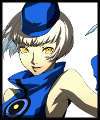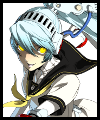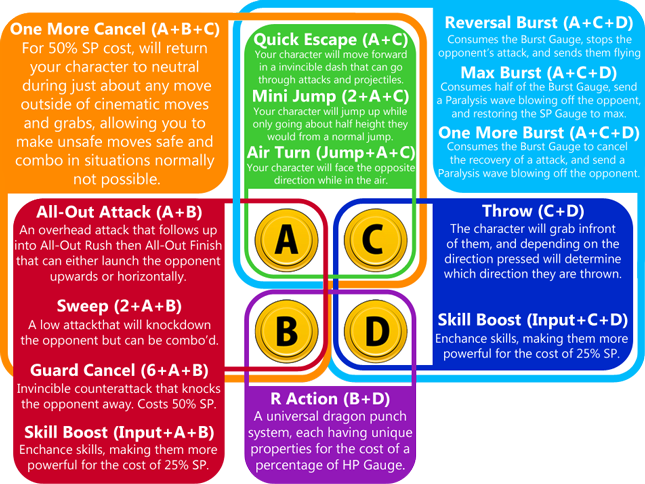
The second collaboration between Atlus and Arc System Works, Persona 4 Arena Ultimax (known as Persona 4: The Ultimax Ultra Suplex Hold in Japan) is a 2D fighting game and direct sequel to Persona 4 Arena, released in 2012.
*Disclaimer:
If you do not want Persona 3 or Persona 4 spoiled, AVOID THIS THREAD. This is the sequel to the sequel to Persona 4, and the character roster itself contains spoilers for both games.

- Developers: Atlus (P Studio) and Arc System Works
- Publisher: Atlus
- Release Date (Japan): August 28, 2014
- Release Date (North America): September 30, 2014
- Platform: PlayStation 3 (and Xbox 360 in North America)
- Ratings: CERO: B, ESRB: T

A few days after the events of Persona 4 Arena, The Midnight Channel has begun broadcasting once again. Featuring a tournament called the "P-1 Climax", all of the participants from the previous "P-1 Grand Prix" tournament in Persona 4 Arena are shown fighting each other. Soon after it airs, a red fog begins to cover Inaba, causing the disappearance of the townsfolk and melding the real world and the TV world. At the same time, the Dark Hour from Persona 3 seems to have returned and, with it, the ominous tower known as Tartarus.
Mitsuru, Akihiko, Aigis and Fuuka have been captured and crucified. A mysterious person known as Sho Minazuki appears, claiming to be the culprit behind all of the incidents. Adachi has returned with hidden motivations of his own. Shadows of the protagonists have appeared, getting in their way. The Investigation Team and remaining Shadow Operatives—gathered from former SEES members as the "Shadow Operative Auxiliary Staff"—vow to save the captives and solve the mystery behind the events.
The story is divided into four episodes: Episode P4A (DLC), Episode P3, Episode P4 and Episode Adachi (DLC). With the exception of Episode P4A—which is a summary of the events in Persona 4 Arena—the story episodes convey Persona 4 Arena Ultimax's narrative through the perspective of their titular characters, without following an individual character chapter format like P4A did. The requirement to start Episode P3 and Episode Adachi is the completion of Episode P4.































In addition to the 9 new playable characters, every character also has a playable Shadow version of themselves (except for Elizabeth, Shadow Labrys, Sho, Minazuki, Adachi, Marie and Margaret):



- Golden Arena Mode
New mode introduced in Ultimax, GAM resembles the BlazBlue series' Abyss Mode. Players pick one of four difficulty settings and battle AI opponents in order to advance floors in a dungeon, gaining EXP in the process. When a character gains a certain amount of EXP, they level up and players are able to distribute attribute points to any of 5 status parameters: Strength, Magic, Endurance, Technique and Luck.
Leveling up will also grant players with new skills to equip. Characters can be equipped with a max. of 4 skills and there are over 100 in total. Special skills can also be obtained by defeating boss enemies at certain floors.
When starting this mode, players can choose a navigator character to be their partner. As players battle accompanied by their partner, their Social Link level with the partner will increase, granting the navigator with special skills that will help the player in fights.- Story Mode
The 20+ hour long story Mode is divided into two branches: one for the Persona 3 perspective called "Episode P3" and one for that conveys the Persona 4 characters' perspective of the story called "Episode P4." There are two DLC story chapters as well: one featuring a recap of the story from the first Persona 4 Arena and the other featuring Adachi.- Arcade Mode
Standard arcade mode where players pick a character and fight through a series of opponents, with minimal amounts of story inserted in-between fights.- Score Attack Mode
Returning from P4A, SA mode consists of choosing one of four difficulty settings, facing a series of opponents and trying to achieve the highest score possible.- Lesson Mode
A tutorial mode which teaches players the intricacies of the game systems and mechanics.- Versus Mode
Standard VS. mode where two players playing locally can fight against each other.- Training Mode
Standard Training mode where players can practice combos and techniques in specific situations against a programmable AI opponent.- Challenge Mode
A mode in which players are required to complete character specific combos which progressively increase in difficulty.- Replay Theater
Where players can view matches they saved against online opponents.- Gallery Mode
Where players can rewatch cutscenes, look at different story scene images and listen to the Sound Test.

- Player Matches
Players can face each other in non-ranked matches in lobbies of up to 8 players.- Ranked Matches
Players fight in ranked matches, gaining character specific rank points (PSR) as well as a general grade ranking based on their skill level, which can increase or decrease depending on overall performance.- Lobby
Much like BlazBlue: Chronophantasma, players can roam around in virtual lobbies with a custom avatar of their choice, communicating with other players and fighting against them.


HP Gauge

Gauge that indicates a character's remaining health. When the bar is completely depleted, the character will lose the round.
A blue gauge represents temporary health loss, which will recover over time but will disappear if the character is hit. Blue health occurs when a character receives chip damage, when a character uses a Furious Action (see: Controls) and when a character cancels a special into a super.
Different characters have different amounts of HP.
SP Gauge

Gauge that indicates a character's remaining special gauge, which is used for moves that require SP such as supers or One More! cancels.
The maximum amount this gauge can reach is 100 SP, however that increases to 150 SP upon Awakening (see: Game Systems).
Burst Gauge

Gauge that represents a character's ability to Burst. When the gauge is full, a character is able to Burst. When the gauge is only a B, Burst is unavailable while the gauge is slowly refilling. When the Burst gauge is covered by a red X, a Burst cannot be used in that specific moment (i.e. during an opponent's super).
Persona Gauge

Gauge that indicates a Persona's remaining cards, which represents their health. When a Persona is hit, they will break, removing one card from the Persona Gauge. When all cards are gone, the Persona is broken and any move requiring a Persona will be temporarily unavailable until the gauge refills.
Different characters have different amounts of Persona cards.
Round Timer

Represents the time remaining in a round. When the timer hits 0, the opponent with the most HP will win the round.
Round Indicator

Represents the amount of rounds won or rounds left to win in order to take the match.




Additionally, Persona 4 Arena Ultimax introduces a new gameplay mechanic similar to the Guard Cancel: the Quick Escape Cancel. They're performed in a similar way as Guard Cancels: 6+A+C during block stun, which will perform a Quick Escape while the opponent is attacking, costing 50 SP.

- Auto-combo
Pressing A repeatedly while hitting an opponent will lead to a unique, automatic combo that will also automatically perform special moves and end with a super move if the character has the 50 SP to activate it.- Awakening
Once a character's HP is reduced to around 35%, the character will enter Awakening mode, shown by the change in color for their HP and SP Gauge, as well as a close-up image of the character's eyes. Once having entered Awakening, the maximum value of the SP gauge will become 150 SP instead of 100 SP, the damage a character receives will be reduced by around 60% and a special set of supers known as "Awakening supers" will become available to activate.- Shadow characters
New mechanic introduced in Persona 4 Arena Ultimax, Shadow characters differ in the following ways from their normal counterparts (with the exception of the Shadow Labrys that uses Asterius):
- Shadows cannot Burst.
- Shadows cannot enter Awakening mode.
- Shadows maintain their SP between rounds.
- Shadows of returning Persona 4 Arena characters use different auto-combos compared to their normal counter-parts.
- Shadows deal 20% less damage than normal ones.
- Shadows can activate Shadow Frenzy by pressing A+C+D (the typical Burst button combination) with 100 SP. During Shadow Frenzy, SP use is rendered unlimited for a period of time, with a timer that gradually lowers and depletes faster when SP required abilities are used. During this period, special moves can also be cancelled into each other.
- Shadows have 2,000 more HP than their normal counterparts.
- Shadows can activate Awakening Supers whenever they want to, given the necessary amount of SP.- S Hold System
New system introduced in P4AU, holding A for a period of time will increase the S Hold gauge, activating special moves and supers—depending on how long the button is held—that can have special properties.- Skills
Unique attacks that are usually performed with 236 and 214 motions.- SP Skills
More powerful, EX variations of normal skills which cost 25 SP to perform.- Supers
Powerful attacks that cost 50 SP to activate.- Skill Boost Supers
New to Ultimax, SB Supers cost 75 SP and are more powerful versions of normal supers (e.g. Chie summoning two fists from the sky for her God Hand instead of one).- Instant Kill
True to the name, IK moves are moves that can only be performed when a player has one round remaining to take a match and also has 100 SP. These are special moves that will immediately end a match if they successfully hit an opponent.

Certain attacks and abilities inflict negative status effects on opponents. These status effects can only be removed in one of two ways: by landing a successful hit on the opponent or by waiting a certain amount of time before the status effect disappears. Characters can be affected by multiple status effects at the same time.
- Poison
The character's HP gradually decreases, accompanied by a heartbeat sound.- Confusion
The player's left and right directional controls are reversed.- Fear
Any hit the character receives will be a fatal counter and the character will be unable to escape throws while afflicted by this effect.- Rage
Characters afflicted by this are unable to block, however their attack power increases by 20%. This status effect is not removed once a hit is landed on the opponent.- Mute
Characters are unable to use their Personas while this effect is active, disabling abilities such as supers and Burst.- Shock
Characters are unable to move in any way except for using: Quick Escapes and Short Hops.- Charm
Characters will have their SP slowly drained and added to the opponent's SP gauge, even if the charmed character's SP gauge is at 0.- Freeze
The character is unable to move while frozen. The effect is removed once the character is hit, or by rapidly alternating left and right on the directional inputs.- Negative Penalty
This effect is inflicted when a player runs away from their opponent for too long. A warning will be given to a player in danger of being afflicted by this and, unless the character proceeds to then approach the opponent, they will receive a Negative Penalty. Their defense will dramatically reduce and the penalty will only go away when the character becomes more aggressive (such as advancing towards the opponent).


(Click here for more)









OFFICIAL WEBSITES
INFORMATION
NEOGAF MATCHMAKING










